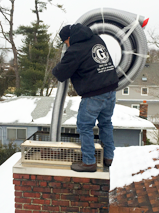A broken flue can be hazardous to your chimney
There are way too many people to count who take their chimney maintenance for granted. What they don’t understand is that your chimney is more than just a tower of bricks that funnel smoke from your home. There aren’t a lot of moving parts to a chimney, but each one is delicately designed and if one part stops moving because of negligence, it could end up costing you thousands in repairs.
What everyone seems to be most familiar with is the damper. The damper is what prevents the cold from entering your home when it’s closed and it lets the smoke out of your home when it’s open-it should only be open during cleaning or when running a fire. The other part you usually notice is the door in the firebox that allows the ash to flow down to the ash box.
Your chimney is what protects the inside of your home from fire, moisture, noxious fumes and smoke and all of those are seriouz hazards to you and your family.
those are seriouz hazards to you and your family.
So, what is the flue and where is it? The flue is what provides the passage of smoke and gasesfrom your fireplace or woodstove. It runs all the way to the top of your roof and rises above it. You call it a chimney but it is the flue. Flues can be lined or unlined, but unlined flues are extremely dangerous. There are a variety of linings for a flue but the most common are steel and ceramic.
The part of your chimney that extends beyond your roof is constantly exposed to the elements and living in the Boston area in the Northeast, they become exposed to snow and heat. All of this exposure has a detrimental effect on the liner of your flue. It can cause cracks, flaking and gaps in the masonry that can allow gases and moisture to migrate from the inside of your flue into your home.
The gaps and cracks that come from negligence and inefficient cleaning can cause your chimney bricks to loosen. It can cause your chimney to shift and to not stand straight, which could jeopardize your roof as well. It can also cause your chimney bricks to fall and if left alone to further deteriorate can eventually cause your chimney to fall apart resulting in roof damage, falling bricks and the worst case scenario, a falling chimney.